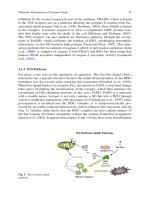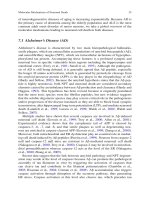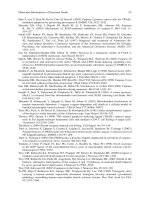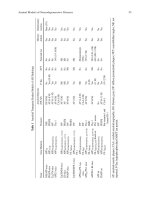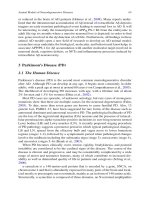Neurochemical Mechanisms in Disease P4 docx
Bạn đang xem bản rút gọn của tài liệu. Xem và tải ngay bản đầy đủ của tài liệu tại đây (276.12 KB, 10 trang )
Mechanisms Versus Diagnoses 15
Navon R et al (1973) Am J Human Genet 25:287–292
O’Neill B et al (1978) Neurology 28:1117–1123
Oonk JGW et al (1979) Neurology 29:380–384
Porteus DJ, Thompson P, Brandon NJ, Millar JK (2006) The genetics and biology of DISC 1 – an
emerging role in psychosis and cognition. Biol Psychiatry 60:123–131
Posner JB (2003 Sept) Immunology of paraneoplastic syndromes: overview. Ann N Y Acad Sci
998:178–186
Rapin I et al (1976) Arch Neurol 33:120–130
Renshaw PF et al (1992) Ann Neurol 31:342–344
Rosebush PI et al (1995) J Clin Psychiat 56:347–353
Skolnick EM (2006) Mechanisms of action of medicines for schizophrenia and bipolar illness:
status and limitations. Biol Psychiatry 59:1039–1045
Molecular Mechanisms of Neuronal Death
Elena M. Ribe, Lianna Heidt, Nike Beaubier, and Carol M. Troy
Abstract Cellular homeostasis, maintenance of the balance of life and death at the
cellular level, is essential for tissue integrity from development through senescence.
During development of the nervous system programmmed cell death is responsi-
ble for establishing the number of neurons and shaping the nervous system. After
development the majority of the postmitotic neurons should live for the life of
the organism. Aberrant neuronal death occurs in neurodegenerative diseases and
there i s still no clear understanding of the mechanisms involved. In this chapter we
discuss the molecules and pathways that regulate the life and death of cells and illus-
trate how these pathways are potentially involved in neurodegenerative diseases. By
understanding the molecular mechanisms that regulate cell death we can then begin
to identify which pathways are dysregulated in neurodegenerative diseases.
Keywords Neuron death · Caspase · IAP · Smac/DIABLO · TNF · Fas · PIDD ·
RAIDD · Neurodegenerative disease
Contents
1 Introduction 18
2 Caspases: Key Players in Apoptosis
19
2.1 Caspase Activation
20
2.2 Mechanisms of Activation
20
2.3 The Apoptosome
21
2.4 The DISC
21
2.5 The PIDDosome
22
2.6 The Inflammasome
23
3 Apoptotic Routes: Intrinsic and Extrinsic Pathways
23
3.1 The Extrinsic or Receptor-Mediated Pathway
23
C.M. Troy (B)
Departments of Pathology and Neurology, Taub Center for the Study of Alzheimer’s Disease and
the Aging Brain, Columbia University Medical Center, New York, NY 10032, USA
e-mail:
17
J.P. Blass (ed.), Neurochemical Mechanisms in Disease,
Advances in Neurobiology 1, DOI 10.1007/978-1-4419-7104-3_2,
C
Springer Science+Business Media, LLC 2011
18 E.M. Ribe et al.
3.2 The Intrinsic Pathway
26
4 Natural Inhibitors of Caspase Activity
28
4.1 The Inhibitor of Apoptosis Proteins
28
4.2 Natural Inhibitors of the Inhibitor of Apoptosis Proteins: IAP Antagonists
31
4.3 Phosphorylation
31
4.4 Nitrosylation
32
5ER-Stress
32
6 Crosstalk Between the Intrinsic and Extrinsic Pathways
33
7 Neurodegenerative Diseases: An Example of Dysregulated Apoptosis
34
7.1 Alzheimer’s Disease (AD)
35
7.2 Amyotrophic Lateral Sclerosis (ALS)
36
8 Dissecting Death Pathways in Vivo
38
References
39
1 Introduction
Cellular homeostasis, that is, t he balance of life and death at the cellular level, is
a requirement for maintaining the integrity of tissues from development through
maturity. During development large numbers of superfluous cells are removed by
an active process termed programmed cell death (PCD) (Burek and Oppenheim,
1996). It was through the genetic studies of developmental death in C. elegans that
the genes required for PCD were identified (Hengartner and Horvitz, 1994). These
gene families are highly conserved from C. elegans to humans. Often PCD is used
interchangeably with apoptosis; this is not accurate, as PCD refers specifically to
developmental death. Apoptosis and necrosis were described as morphologically
distinct processes (Kerr et al., 1972). In apoptosis cellular changes include cell
membrane blebbing, cell shrinkage, chromatin condensation, and nuclear fragmen-
tation (Kerr et al., 1972). Eventually the cell disintegrates, generating the so-called
apoptotic bodies that will be engulfed via phagocytosis by nearby cells, thus avoid-
ing an inflammatory response in the surrounding tissue. This lack of inflammatory
response allows apoptosis to occur without damaging neighboring healthy cells. In
contrast, necrosis, in which the cell suffers a major insult leading to rapid swelling,
subsequent rupture of the plasma membrane and release of the intracellular contents
into the surrounding cellular environment causes a strong inflammatory response.
Apoptosis maintains physiological balance and its dysregulation results in patho-
logical conditions, such as neurodegenerative diseases, cancer, and autoimmune
disorders. Another mode of cell death is autophagy, which is characterized by the
formation of large autophagic vacuoles and little inflammation (Levine and Yuan,
2005). Most autophagy does not lead to cell death but is a mechanism by which
intracellular components are recycled (Yoshimori, 2007). Although the classifica-
tion of the different forms of cell death seems to be clear, the boundaries are not
so well defined in vivo and crosstalk can occur (Lockshin and Zakeri, 2004). With
this idea in mind, we discuss the pathways of apoptotic neuronal death that occur in
Molecular Mechanisms of Neuronal Death 19
acute and chronic pathological conditions such as Alzheimer’s disease, Parkinson’s
disease, Huntington’s disease, stroke/ischemic disease, and motor neuron diseases.
2 Caspases: Key Players in Apoptosis
Caspases are the main proteins involved in the execution of apoptosis (Troy and
Salvesen, 2002). They are a family of cysteine aspartate proteases with a conserved
QACXG motif at the active site. To date, 13 mammalian caspases have been iden-
tified (Lamkanfi et al., 2002). Synthesized as inactive precursors or zymogens, they
can be classified based on their structure, mode of activation, cleavage specificity,
and function. According to their function caspases can be subdivided into three
groups, shown in Fig. 1:
COOH
COOH
COOH
COOH
COOH
COOH
COOH
COOH
COOH
COOH
COOH
COOH
COOH Caspase-2
Caspase-9
Caspase-10
Caspase-8
Caspase-7
Caspase-6
Caspase-3
Caspase-14
Caspase-12
Caspase-11
Caspase-5
Caspase-4
Caspase-1
402
373
418
373
419
257
277
293
303
479
521
416
435
p12
p12
p12
p12
p12
p12
p12
p12
p12
p12
p12
p12
p12
p19
CARD
CARD
CARD
Inflammatory
caspases
Effector
caspases
Initiator
caspases
NH
2
NH
2
NH
2
NH
2
NH
2
NH
2
NH
2
NH
2
NH
2
NH
2
NH
2
NH
2
NH
2
1
1
1
1
1
1
1
1
1
1
1
1
CARD
CARD
Prodomain
Prodomain
Prodomain
DED
DED
DED
CARD
CARD
DED
p19
p19
p19
p19
p19
p19
p19
p19
p19
p19
p19
p19
Fig. 1 Mammalian caspases
(1) Inflammatory caspases: caspase-1, -4, -5, -11, -12, and -14.
(2) Initiator caspases: involved in the apoptotic process. These caspases, also
known as apical caspases, are structurally characterized by the presence of a
long prodomain at the N-terminal region containing different protein–protein
interaction motifs such as death effector domain (DED) found in caspase-8 and-
10 or caspase recruitment domain (CARD), present in caspase-2 and -9. Via
20 E.M. Ribe et al.
these domains, caspases establish homotypic interactions with specific adaptor
molecules.
(3) Effector caspases: this group of proteases cleave cellular substrates during apop-
tosis. Due to their function in the apoptotic paradigm they are also known
as executioner caspases. They are characterized by the presence of short
prodomains. This group contains caspase-3, -6, and -7.
2.1 Caspase Activation
Synthesized as inactive precursors or zymogens, caspases require activation to exe-
cute apoptosis (Nicholson and Thornberry, 1997). Early studies suggested that all
caspases required proteolytic cleavage for their activation and that mature caspases
consisted of large (p18/20) and small (p10/12) subunits arranged in heterotetramers
containing two active sites (Walker et al., 1994). However, work on caspase-9
provided new insight into the mechanisms underlying caspase activation because
it demonstrated that the caspase-9 zymogen could have activity without cleavage
(Stennicke et al., 1999). Thus, the question, “How do caspases become activated?”
is critical.
2.2 Mechanisms of Activation
2.2.1 Effector Caspases
The common mechanism of activation of effector caspases (caspases-3, -6, and -7)
is through proteolytic cleavage at critical aspartic acid residues (Quan et al., 1996;
Riedl et al., 2001a) shown in Fig. 2. Effector caspases are activated by other
proteases, generally initiator caspases or granzyme B (an aspartate-specific serine
protease), or other effector caspases. This cleavage process has two steps. First,
a molecule of zymogen is cleaved at the linker region generating the p18/20 and
p10/12 subunits; this structure is partially active. Then, this intermediate interacts
with another heterodimer forming the active caspase. In this regard, cleavage of the
effector caspase is a measure of activation. Once effector caspases become active
they are able to cleave multiple substrates to induce cell death.
2.2.2 Initiator Caspases
Inactive initiator caspases exist as monomers and activation is achieved by
proximity-induced dimerization (Boatright and Salvesen, 2003) shown in Fig. 2.
Adaptor proteins, which interact with the prodomains of the caspases, bring the
caspase molecules into proximity. When initiator caspases dimerize, they undergo
conformational changes that result in an active enzyme without a requirement for
Molecular Mechanisms of Neuronal Death 21
APOPTOSIS
DD
DD
DD
DD
Death
substrates
Effector
caspase
Initiator
caspase
Caspase Activation
Fig. 2 Caspase activation
cleavage. Thus, cleavage cannot be used as a measure of activation when study-
ing initiator caspases. Because caspase-9 is an initiator caspase that does not
require cleavage for its activation, some studies have used the cleavage of caspase-
3 as a surrogate measure for caspase-9 activation. However, caspase-8 can also
cleave caspase-3. Thus, caspase-3 cleavage/activity is not a specific measurement
of caspase-9 activation.
2.3 The Apoptosome
The most widely s tudied model is caspase-9 activation. Release of cytochrome
c from the mitochondria into the cytosol promotes the assembly of the apopto-
some, a complex composed of cytochrome c, Apaf-1 (Apoptosis protease-activating
factor-1), and caspase-9. The presence of Apaf-1, which is the specific adaptor for
caspase-9, recruits procaspase-9 to the apoptosome resulting in caspase-9 activation
(Bao and Shi, 2007; Riedl and Salvesen, 2007).
2.4 The DISC
A similar process occurs for caspase-8 activation. In this case, oligomerization of the
death adaptor protein Fas-Associated Death Domain (FADD) recruits procaspase-8
into the death-inducing signalling complex (DISC) allowing caspase-8 dimerization
and subsequent activation (Shi, 2006).
22 E.M. Ribe et al.
2.5 The PIDDosome
An activating complex has also been identified for caspase-2, containing RAIDD
(RIP-associated ICH-1/CED-3 homologous protein with a death domain), the spe-
cific death adaptor for caspase-2, and PIDD (p53-induced protein with a death
domain) (Tinel and Tschopp, 2004; Park et al., 2007). This complex, termed the
PIDDosome, has not been shown to actually mediate caspase-2 dependent death
but rather, overexpression of PIDD can lead to cleavage of caspase-2 which is not
necessarily an indication of activation (Tinel et al., 2007). Overexpression of PIDD
does lead to death that is blocked in RAIDD-null cells (Berube et al., 2005). PIDD
can also complex with RIP1 and NEMO and induce activation of NFκB, suggesting
a dual function for PIDD in the regulation of survival and death (Janssens et al.,
2005). Caspase-2 has been shown to be critical for both trophic factor deprivation
and β-amyloid mediated neuronal death (Troy et al., 2000, 2001), shown in Fig. 3
and RAIDD is required for execution of trophic factor deprivation mediated death
(Wang et al., 2006).
Once dimerized in the activating complexes there is often autocleavage of the
caspase which, for caspase-2 and -8, has been shown to enhance caspase activity
(Chang et al., 2003; Baliga et al., 2004). As death proceeds and effector caspases are
activated there is subsequent cleavage of initiator caspases. This cleavage may lead
to further enhancement of caspase activity, as in the case of caspase-9 where the ini-
tial autocleavage of caspase-9 to the p37 fragment allows XIAP to bind and inhibit
activity, and the subsequent cleavage by caspase-3 to the p35 fragment relieves the
XIAP inhibition thus enhancing caspase-9 activity (Denault et al., 2007).
Caspase-2 and PIDD Signaling Pathways
Trophic Factor
Deprivation
Aβ
RIP 1
NEMO
NF κB
activation
Cell repair
IAP’s
C-3
Cytoplasm
Caspase-2
activation
RAIDD
PIDD
PIDD
Caspase-2
PIDO
APOPTOSIS
Fig. 3 Caspase-2 activation and PIDD signaling pathways
Molecular Mechanisms of Neuronal Death 23
2.6 The Inflammasome
The activation of the inflammatory caspases uses a mechanism resembling that of
the initiator caspases. The presence of a complex, known as the inflammasome
(Martinon et al., 2002), is required for activation of this set of proteases. The
recruitment of caspases into this complex results in their activation. For caspase-
1, the adaptor ASC ( apoptosis-associated specklike protein containing a CARD)
is critical in inflammasome formation in response to a variety of stimuli, whereas
involvement of the adaptors Ipaf (ICE-protease-activating factor) and NALP3 is
stimulus-dependent (Mariathasan, 2007).
3 Apoptotic Routes: Intrinsic and Extrinsic Pathways
Cells undergoing apoptosis take one of two major pathways: the death receptor
(extrinsic) pathway, or the mitochondrial (intrinsic) pathway. Once the cell is dead,
the cellular contents form the apoptotic bodies, which are cleared by phagocytosis
in a process involving neighboring cells and/or macrophages. This intricate process
is tightly regulated so that there is a fine balance between prosurvival and prodeath
signals for each route in the apoptotic pathway.
3.1 The Extrinsic or Receptor-Mediated Pathway
The extrinsic or receptor-mediated pathway is activated when a death ligand binds
to its specific receptor on the cell membrane surface. The main death receptors are
all members of the tumor necrosis factor (TNF) superfamily of receptors, which
includes TNFR, Fas, p75, and TRAIL. All these r eceptors are characterized by
the presence of domains rich in cysteine, which mediate the binding between lig-
and and receptor. The receptors are synthesized as transmembrane homotrimers
and when they bind to their specific death ligand a DISC is formed. This com-
plex recruits death domain (DD)-containing adaptor proteins that interact with and
recruit procaspase-8, leading to caspase-8 activation. Caspase-8 activation results in
the cleavage and activation of downstream effector caspases which in turn cleave a
plethora of substrates, ultimately leading to cell death. Caspase-10, present only in
humans, is also activated in this way.
3.1.1 TNF Pathway
TNF is a proinflammatory cytokine produced mainly by macrophages. There are
two main types of receptors, TNF-R1 and TNF-R2. TNF-R2 is primarily found
in the immune system and is activated by membrane-bound TNF (Wajant et al.,
2003). However, TNF-R1, which is ubiquitously expressed, can be activated by
both membrane-bound and soluble TNF. When TNF binds to the TNF recep-
tor, TRADD (TNFRSF1A-associated via the death domain) is able to establish
24 E.M. Ribe et al.
TNF Signaling Pathways
TNFα
TRAF2
TRADD
MAP3K
MKK7
JNK
Jun
Fos
TRAF2
TRADD
FADD
TNF-R1
C-8
C-10
C-3
APOPTOSIS
XIAP
C-8
Active
caspase-8
Flip
Flip
RIP
p65
p65
p65
Iκβ
Iκκβ
Iκκα_
Iκβ
NEMO
p55
p55
p55
Fig. 4 TNF signaling pathways
homophilic interaction with the DD of the TNF receptor (Hsu et al., 1995),
shown in Fig. 4. The binding of TRADD to the TNF receptor–ligand complex
facilitates the subsequent binding of TRAF2 (TNF receptor-associated factor 2)
and RIP1 (receptor-interacting kinase-1), a DD-containing serine threonine
kinase.
When TRAF2 and RIP1 bind to the complex, two sequential pathways are acti-
vated: the NFκB pathway and the activated caspase-8 pathway. In the first step of the
NFκB pathway, TNF activates the IκBα pathway in a process that depends on the
degradation of the inhibitor IκB by the proteasome. The Iκκ complex (IκB kinase)
mediates the phosphorylation of the inhibitor IκB. The Iκκ complex is formed by
two related IκB kinases, IκBα and IκBβ, and NFκB essential modulator (NEMO),
a regulatory protein also known as IκBγ. The roles of TRAF2 and RIP in the Iκκ
complex are recruitment and stabilization, respectively (Devin et al., 2003).
In nonstimulated cells, the Iκκ complex remains inactive in the cytoplasm
because of the binding of the IκB inhibitor. However, when the complex is recruited
to the TNF receptor it becomes active and it is able to phosphorylate the IκB
inhibitor which is in turn degraded via the proteasome (Aggarwal, 2003). The degra-
dation of the inhibitor frees the NFκB complex to translocate to the nucleus where
it activates transcription of several genes, including XIAP, c-IAP1, and c-IAP2
(Stehlik et al., 1998; Wajant, 2003).
Thus, TNF induces a strong prosurvival signal secondary to NFκB activation.
This is the main difference between TNF and Fas or TRAIL, which only medi-
ate apoptosis. TNF can have cytotoxic effects, but only when NFκB activation is





